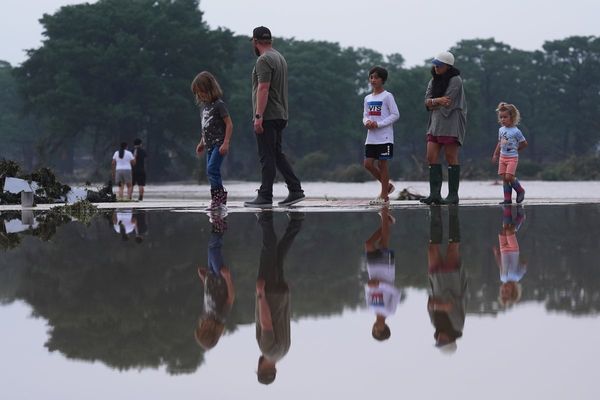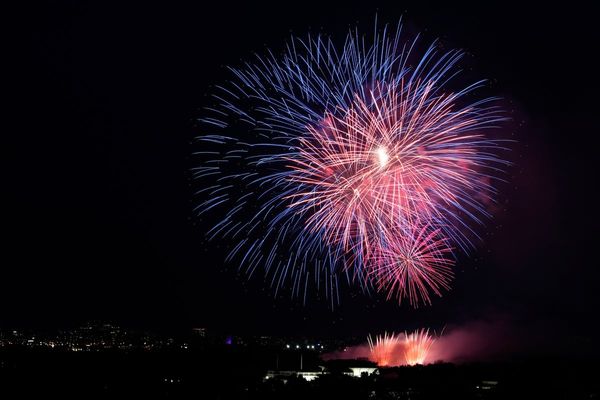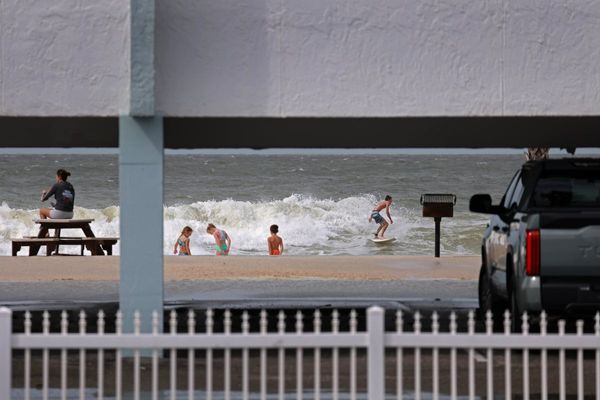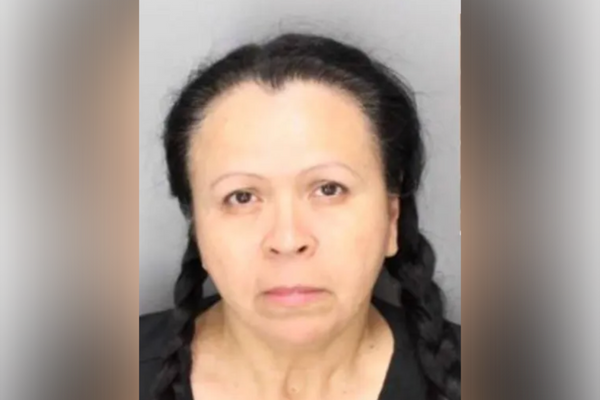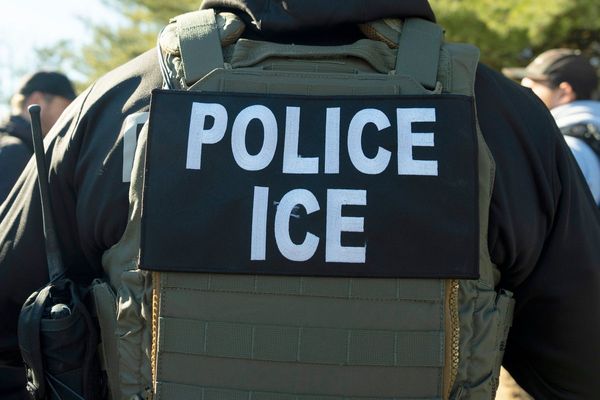
YONAGUNI, Okinawa -- The Japanese archipelago's westernmost island of Yonaguni in Okinawa Prefecture is home to an endangered breed of horse -- the Yonaguni-uma, one of the nation's eight indigenous breeds.
I headed for the island's Agarizaki district where these horses graze, traveling along the seashore, with its long line of sheer cliffs.
Arriving at the Agari Bokujo ranch, from where you can see a lighthouse, I spotted a herd of about 20 horses eating grass.

The ranch is devoid of shade, so the mid-summer sunshine bears down harshly on the horses, their manes fluttering with every gust of seabreeze.
At their withers, the grown Yonaguni-uma are about 120 centimeters tall, remarkably small compared with dosanko horses, an indigenous breed in Hokkaido, and the Japanese thoroughbred. Their coats are predominantly bay or nut-brown.
Several colts were among the herd, staying close to their parents.

I approached closer to take some photos. One of the adults had a glimpse of me, but didn't seem bothered by my presence, probably because they've rarely been mistreated by humans.
An explanatory board beside the road says these horses "are tough, can endure a coarse diet and have a meek nature."
Yonaguni-uma have been bred on the island for more than 400 years. They have been used to transport sugar cane, carry fish, draw horse wagons and plow fields. For the islanders toughing out a living in this rough, remote environment, Yonaguni-uma horses were essential livestock.

Yet this breed once faced a serious risk of extinction. In 1968, their population was counted at 210. The following year, the Yonaguni town government designated the breed as the town's natural treasure. As their agricultural roles diminished with the introduction of farm machinery, so did their numbers, falling below 60 in 1975.
In that year, the Yonaguni-uma Hozonkai, an association for preserving the breed, was established. Currently, the population has recovered to about 130.
Kazuhide Maeso, 42, of the association said: "There are 30 members of the association on this island. They own the horses and make efforts to breed and preserve them with assistance from the Japan Equine Affairs Association. Each of the horses is implanted with a microchip to help improve their care and preservation."

It is not entirely clear how the horses' ancestors first arrived on the island.
Yonaguni is 509 kilometers from Okinawa main island, and 127 kilometers from Ishigaki Island. To the west, Taiwan is 111 kilometers away.
I wanted to deeply feel that I was on an island on the country's very edge, so I went to a spot near the Irizaki district, where a monument stands indicating Japan's westernmost point.
The place is described as "a hill where Japan's latest sunset can be seen." Local people say that several times a year, on a clear day, visitors can see the mountain ridges of Taiwan.
I stood on the hill and looked out over the horizon. I could not see Taiwan, as there were thin clouds in the sky. But the deep blue vast expanse of ocean, in which the Black Current -- one of the world's largest sea currents -- flows, was so impressive that I gazed in wonder at the sea for a while.
The scenery around the hill is called Kubura Furishi. Its unique view was created by Ryukyu limestone and sandstone.
In a part of this area is a place called Kubura Bari, which is known for tragic episodes in the past. There is a gigantic rock with a split, 20 meters long, three to five meters wide and eight meters deep.
It is said that the local people suffered heavy burdens from a per-capita tax during years of the Ryukyu Dynasty (15th to 19th centuries), and thus pregnant women were coerced to jump over the cleft to force miscarriages to prevent the local population from increasing.
Setting aside those tragic episodes, the natural environment was not the only cause of hardships for local residents living on the remote island.
On the other hand, because the island is separated from the mainland by a vast ocean, Yonaguni-uma horses could avoid cross-fertilization with other horse breeds and breed improvement. Also, since the Meiji era (1868-1912), when larger horses for military use were sought after, the degree of purity of these indigenous horse breed could be maintained. It's practically a miracle that they've survived.
Many Japanese indigenous breeds of horse have ceased to exist. They include the Nanbu-uma in Iwate Prefecture, which is where I'm from. Looking at the shoe-button eyes of Yonaguni-uma horses, I could not help feeling a desire that these indigenous horses will be able to carry on.
Underwater view
A mysterious rock formation on the seabed off the southern shore has been attracting attention from around the world. In 1986, a huge stairway-shaped structure was found, causing speculation that it may be an underwater ruin.
The town government's conclusion is that, "We consider it a natural thing, not a ruin." But many people visit the site as they want to see the superb view, either up close in scuba gear, or from the comfort of a glass-bottom pleasure boat. Either option depends on the weather, tides or number of guests, so it's necessary to confirm in advance what services are available.
Yaeyama soba noodles
Yaeyama soba noodles are a must-eat on the island. It is a variety of Okinawa-style noodles, which were developed in the Yaeyama Islands, to which Yonaguni Island belongs. Although the name is soba, relatively thin noodles made only with wheat flour -- not including buckwheat flour -- are used in the cuisine.
The soup base is made from pork bones and niboshi dried fish, with the flavor of bonito added to balance the taste.
I dropped in at a diner near Higawahama beach, where a location set for the popular TV series "Dr. Coto's Clinic" remains. In the diner, a bowl of almost straight noodles topped with juicy simmered pork slices, kamaboko boiled fish paste and tips of Welsh onion was served. I ordered a lunch set. Small dishes of goya (bitter gourd) and mozuku seaweed were also included. The lunch set is priced at 1,000 yen. In another diner, a bowl of Yaeyama soba noodles topped with whole kuruma-ebi prawns, which are farmed on the island, was served. The soup was deeply miso-flavored. The taste makes people want more.
Spirits that can't be frozen
Hanazake is a spirit produced only on Yonaguni Island. The alcohol percentage is high at 60 percent, but Hanazake has a rich aroma and flavor.
The production method is the same as that of awamori spirits, which are made from rice. Hanazake spirits are produced by extracting liquids with high-percentage alcohol that comes out first in the process of distilling.
The spirits do not freeze because of the high alcohol content. So the recommended way of drinking it is to store bottles in freezers and drink them when the liquid becomes thick.
There are distilleries that accept tourists and offer tasting services. Prices of the spirits widely vary. Bottles of 600 milliliters wrapped with leaves from kuba trees -- also a local specialty product of the island -- are priced from around 2,500 yen each.
Access
About 2 hours and 50 minutes from Haneda Airport to Ishigaki Airport. From Ishigaki Airport, about 30 minutes to Yonaguni Airport. Alternatively from Naha Airport, about 1 hour and 15 minutes to Yonaguni Airport. Or from Ishigaki Island, about 4 hours aboard ferries to Yonaguni.
For information, call the Yonaguni-cho Kanko Kyokai tourism association at (0980) 87-2402.
Read more from The Japan News at https://japannews.yomiuri.co.jp/
